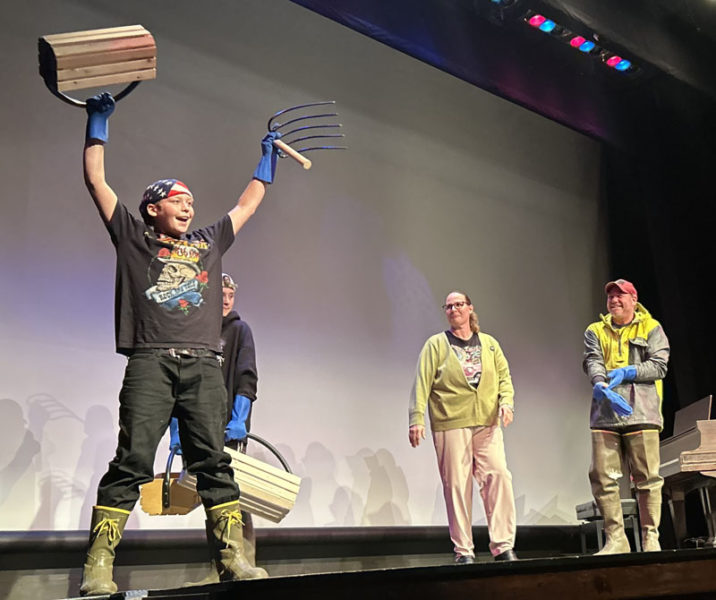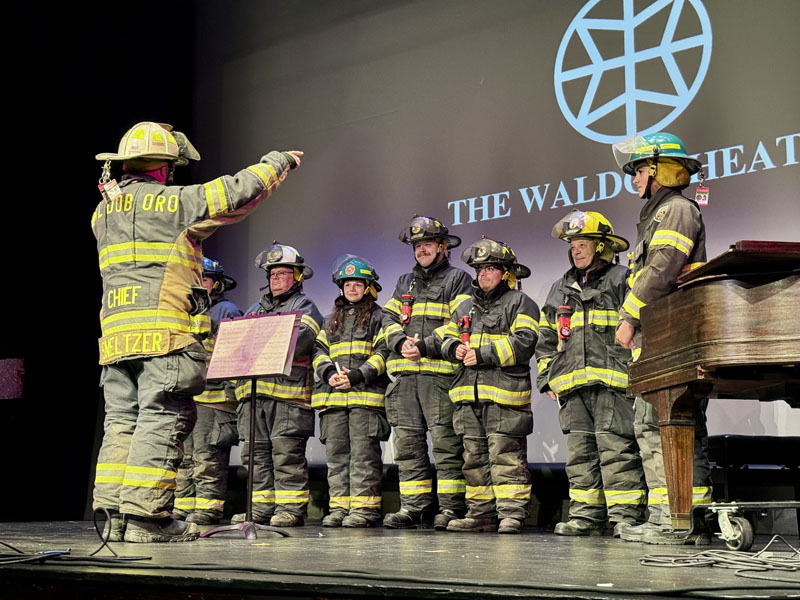
Noah and Jesse Campbell (left) finish performing Do the Clam and head off stage with Loretta Severson and Abden Simmons (right) on Saturday, Nov. 2 at The Waldo Theatre in Waldoboro. (Molly Rains photo)
On the evening of Saturday, Nov. 2, the lights dimmed inside The Waldo Theatre as a full house of about 300 audience members took their seats.
The audience, many finding themselves next to friends and neighbors inside the historic theater, then fell into expectant silence: the first-ever Waldoboro Talent Show was about to begin.
“It’s really for the town. That’s why I did it, because I want us all together, and intentionally, before the election,” said Rebecca Cooney, who organized the event with Michael Amico. “What I really want is for people to walk out and be touched by this evening, and walk out with maybe some fairy dust sprinkled on them. I just wanted us to be all one.”
Cooney intended the show to be specific to Waldoboro, with all but a few performers residing in the town and an audience composed largely of residents.
More than 50 performers took the stage to showcase skills from dance to fashion and poetry. Musical talent abounded, with multiple musicians and singers, among them pianist and Miller School music teacher Laetitia Brundage, the Family of God Quintet, of First Baptist Church; and singer-songwriter Mauri Lord.
Ken Stevenson, president of The Waldo Theatre’s board of directors, engaged the crowd in a sing-along of the “SpongeBob SquarePants” theme. Waldoboro Select Board member Abden Simmons – introduced as “the clam lord himself” by event emcee Samuel Pennington – performed an original dance entitled “Do the Clam” with Loretta Severson and Noah and Jesse Campbell.
Waldoboro EMS performed a comedy skit involving the nail-biting resuscitation of a stuffed shark. Waldoboro Fire Chief Paul Smeltzer led a group of firefighters in a handbell choir performance of “Mary Had a Little Lamb.”
In one act, Kraken, a border collie, leapt through owner Morganne Price’s arms and over jumps, acting out the harrowing journey of alewife fish traveling up the Medomak River to spawn.
“It was such a warm audience,” said Stevenson. “All kinds of different people together to just have a good time.”
Amico said he and Cooney had hoped to create “levity and joy” with the talent show.
“Everyone is really stressed right now. It’s really healthy to decrease stress like this,” he said.
In order for the talent show to succeed as Amico and Cooney imagined, the pair also wanted to create a space for Waldoboro residents to encounter one another outside of their normal roles and spaces, and experience not only joy but also more unexpected emotions together.
“It’s not about simply changing the feel of the world right now from division to joy and laughter. It’s not about that – it’s about simply opening up a space to feel ‘otherwise,’” Amico said.
In line with this goal, the talent show also included quieter moments. Acts were interspersed with projected photographs and pre-recorded audio of Waldoboro residents reminiscing on days past and remembering community members no longer living.
Bob Benner narrated a reflection on the early days of The Waldo Theatre, recalling the praise the building received after its 1936 construction. Other residents spoke about deceased loved ones and community members: Neal Shuman remembered Maurice Vose; Millard Creamer spoke about his father, Arthur Creamer; Elaine Johnston spoke about Nanny Walter; and Becky Maxwell recalled Bushy Boissneault.
The inclusion of the pre-produced segments, said Amico, was intended to bring voices and perspectives from older residents to the show that may have otherwise been excluded.
“It’s part of the performance of the community overall,” he said.
During the show, organizers also paid tribute to Waldoboro residents who died within the last year, projecting their names on the theater’s expansive screen while a recording of the calls of gulls and seabirds played. Cooney said she hoped the tribute would inspire residents to reflect in the wake of the show not only on Waldoboro’s community at present but also on its rich history and past.
“It’s really easy now, and it doesn’t matter whether you’re in a rural or an urban community – you can live in your own world so easily, maybe more so than ever,” Cooney said.
“I think it was a nice way to bring people together,” said select board member Bob Butler, who, with Simmons, led the audience in the Pledge of Allegiance to kick off the show. “I think every single performance, in one way or another, accomplished that goal (of bringing people together).”
Cooney said she worked to gather a diverse group of residents for the show in order to encourage meetings and interactions between community members who may otherwise rarely meet. Amico and Cooney identified socioeconomic, economic, political, and age variances as their metrics for gathering a group of diverse Waldoboro residents in one room for the show.
“It was so important for me to have as much diversity as I could,” Cooney said.
Building on the connections Cooney had already built through her work as writer of the “Waldoboro Voices” column in The Lincoln County News was key to gathering a group of performers representing each corner of town, Amico said.
“I hadn’t personally seen as diverse a group of people sort of put together in one place as I was seeing in her ‘Waldoboro Voices’ column,” he said. “Then we started to think, who else would we want in this show to make it really unique, like no other talent show? And talking about how important it was to have representation from town government and public services.”
Cooney first appeared before the Waldoboro Select Board to request their endorsement of the show – and urge their participation – in May, making regular requests since then. Ultimately, Cooney’s entreatments were successful, with the select board unanimously endorsing the concept of the talent show in May and board members Simmons and Butler participating in the production itself.
“Rebecca needed someone to do it, so I did it,” Simmons said.
Both Cooney and Amico expressed hopes the show would strengthen the Waldoboro community beyond the walls of the theater.
“As we enter the winter, we will have this warm feeling … and we’ll say hello to each other in the street, because we will have seen (each other),” Cooney said in May.
Many of the skills necessary for succeeding on stage are also important in civics, Amico said.
“Being responsive in the moment, able to take in new information that your scene partner gives – these are all things people can use in their daily lives,” as well as at meetings of local government boards and committees, Amico said.
The talent show was presented on a pay-what-you-can ticket price model to make it more accessible to the community at large.
While The Waldo Theatre draws crowds from far and wide, not all Waldoboro residents may feel welcome in the space, Cooney said. That disconnect is something Cooney, Amico, and Waldo Theatre Executive Director Susan Hodder would like to see change.
Ideally, Hodder said, The Waldo would function as a “third space” – a space outside of work or home, where people can come to socialize and relax – for all members of the Waldoboro community. Providing shows involving locals and with a range of topics and price points is one step the theater is taking toward that goal, she added.
Though it is not yet certain whether the Waldoboro Talent Show will continue at The Waldo or another venue in the future, Cooney and Amico are certain that the show will go on.
“I think it should definitely become an annual event and can become an annual event,” said Amico. “It feels so true and so vulnerable and so connected to the space and the people … only theater can do that. I think there’s so much potential. I think we have to keep at it.”
The last performance of the evening was delivered by Waldoboro resident Becky Libby, who honored her late father with a performance of Leonard Cohen’s “Hallelujah,” her first performance since his death a decade ago. As she sang, a photograph of Libby and her father was projected on screen. The audience first grew hushed, then, together, began to quietly sing along.

Waldoboro Fire Chief Paul Smeltzer (left) directs fellow firefighters for a handbell rendition of Mary Had a Little Lamb during the Waldoboro Talent Show on Saturday, Nov. 2 at The Waldo Theatre. (Johnathan Riley photo)






